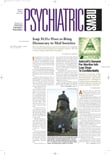Traditional suicide-prevention strategies such as telephone hotlines have not curbed the high suicide rate among youth, according to APA and the American Academy of Child and Adolescent Psychiatry (AACAP).
They submitted a joint statement, titled “Suicide Prevention and Youth: Saving Lives,” to the U.S. Senate Substance Abuse and Mental Health Services Subcommittee hearing last month.
Restricting young people’s access to firearms may reduce the rates of suicide in the short term, “but there isn’t enough evidence yet that this has a permanent effect,” the statement emphasizes.
In addition, traditional suicide-prevention programs frequently minimize the role of mental illness in the suicidal adolescent. The vast majority of adolescents who commit suicide (more than 90 percent) suffered from an associated psychiatric disorder at the time of their death, the statement reported. The most common illnesses among these youth are depression, bipolar disorder, and attention-deficit/hyperactivity disorder.
Males are at much higher risk for suicide than females. Their greatest risk factors are mood disorders, previous suicide attempts, being 16 or older, and substance abuse disorders.
Mood disorders and previous suicide attempts are the greatest risk factors for female suicides, according to the statement.
African-American males have the highest youth suicide rates, which increased 105 percent between 1980 and 1996, according to the 1999 “Surgeon General’s Call to Action to Prevent Suicide.” However, long-term research points to similar risk factors for white youth, risks that include long-term depression and substance abuse, according to the statement.
In addition, gay, lesbian, and bisexual youth experience suicidal thoughts at a significantly greater rate than do their heterosexual counterparts. Among the factors that increase the risk that these youth will consider or attempt suicide are drug and alcohol use and being the victim of chronic bullying, the statement points out (see
page 32).
These were among the strategies that APA and AACAP recommended last month to the Senate subcommittee to curb youth suicide:
• Increase access to mental health care by enacting state and federal mental health parity laws to remove cost barriers to treatment.
• Implement community-based, early-intervention strategies that identify children and adolescents with emotional and behavioral problems.
• Expand geographic and financial access to drug and alcohol treatment.
• Increase research into the causes of suicide and effective treatments to prevent it.
• Reform the juvenile justice and foster care systems so children in those systems receive comprehensive mental health services.
• Increase federal, state, and local support for programs that prevent child abuse and bullying to reduce the high risk for developing depression and other mental illnesses associated with these behaviors.
APA’s Practice Guideline for the Assessment and Treatment of Patients With Suicidal Behaviors is posted online at www.psych.org/psych_pract/treatg/pg/pract_guide.cfm. AACAP’s Practice Parameter for the Assessment and Treatment of Children and Adolescents With Suicidal Behavior is posted at www.aacap.org/publications/pubcat/guideline.htm; nonmembers must pay $15. The surgeon general’s suicide report is posted at www.surgeongeneral.gov/library/calltoaction/default.htm. ▪
